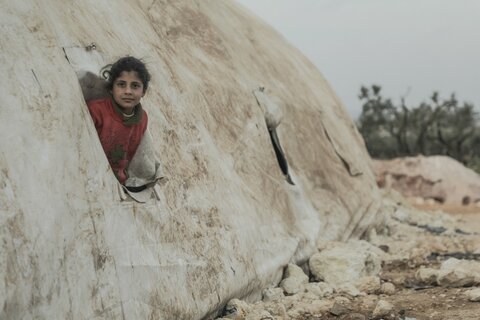No end to world hunger without an end to conflict — WFP warns
Marking International Day of Peace today, the World Food Programme (WFP)'s Executive Director David Beasley is adamant: "There's no two ways about it — we can't end hunger unless we put an end to conflict."
As the world stands on the brink of a hunger pandemic, with the impact of coronavirus threatening to almost double the number of acutely hungry people to 270 million, those living in conflict-affected areas are suffering the most.
According to the Global Report on Food Crises 2019, some 74 million people facing acute hunger live in 21 countries affected by conflict and insecurity — and so do nearly 80 percent of children who are stunted or short for their age, due to chronic malnutrition.

Areas including parts of Yemen, South Sudan, Northeast Nigeria and West Africa's Central Sahel are of particular concern and, while collective action might have staved off famine this year, there are no guarantees that it will not return in 2021.
Now well into its fifth year of conflict, Yemen is crisscrossed by 40 different front lines — more than ever before. Coupled with the near-complete collapse of the economy and the inability of the country's fragile health infrastructure to deal with the spread of coronavirus, this escalation in conflict is pushing the country to the brink of catastrophe.
"In 2018, we sounded the alarm about Yemen slipping into famine, and it was only thanks to decisive action from donors and humanitarian agencies that we could prevent that from happening," Beasley says. "Two years on, any hard-won improvements we managed to achieve have been wiped out, and the country is now at a tipping point."
In a poignant testimony of life in a war zone, 12-year-old Amina, whose family was forced to flee their native Hodeidah to seek shelter in Yemen's capital Sanaa recently said this to a WFP team: "The war can get you in many ways. It is not only the bombings. People suffer when their homes are taken away. People die of hunger and there is not enough water." She also added: "The thing that worries me most is that the war will continue on and on into the future. It will be my future."

"Young Amina's dream is that the fighting will stop, and Yemen will be peaceful again," says Beasley. "And this is what I hear time and again as I travel to war-torn countries. People tell me how they worry about not having enough food to feed their families, but what they often ask for is peace — without that, they know they won't be able to farm their lands, send their children to school, or build a future for their communities."
"We need to act now to build peace and end violent conflict," Beasley continues, noting that "this is the only way to prevent millions of women, children and men from falling into hunger, and save the world billions of dollars in humanitarian food assistance every year."
More than 80 percent of resources requested by UN humanitarian appeals in recent years have been for action in conflict situations.
A weapon of war or a tool for peace?
Lack of food due to conflict is a well-established fact. But the opposite is also true. Food scarcity can fan the flames of existing social tensions, fuel grievances and even further the cause of extremist groups, triggering or exacerbating conflicts.
Worse still, despite its prohibition under international humanitarian law (the law that regulates the conduct of conflicts), the use of food as a weapon of war is still widespread.
Conflict and hunger — Looking back, looking forward

"Food, however, can be a powerful tool to build peace," Beasley says.
With their focus on changing the lives of millions of people for the better, WFP's development activities can help reduce friction that could escalate into conflict. Food Assistance for Assets programmes, in which participants receive assistance to cover their food needs as they build or rehabilitate community assets such as roads, water reserves or irrigation systems, are a case in point.
In Kyrgyzstan, where disputes over natural resources at the southern border with Tajikistan are widely recognized as a source of conflict, WFP's engagement of communities to rehabilitate irrigation canals and pipelines in disputed territories resulted in an increase in water supplies and agricultural productivity, which in turn helped to prevent inter-community conflict over water.
Peacebuilding begins in the barrio

In a handful of countries, decommissioned combatants are included in farming and other income-generating projects to advance their reincorporation into society and foster a stronger sense of community. Examples of this include Colombia, the Pool region of Congo and, most recently, the conflict-ridden Bangsamoro autonomous region in the Philippines, where former combatants are being encouraged to become forest rangers and join farming activities under the joint aegis of local authorities and WFP.
"Peace and food security go hand in hand," Beasley said. "Without political action to end wars and promote stability, and action from the ground to eradicate some of the root causes of conflict, there is no chance of achieving the goal of zero hunger."
